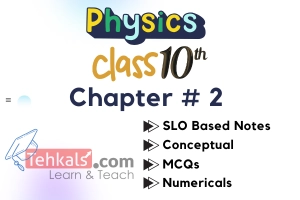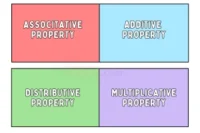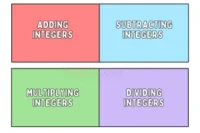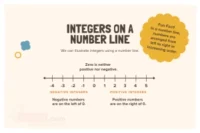Class 10 Physics Chapter 1
Published: 17 Dec 2023
Class 10 Physics Chapter 1 introduces the concept of “Simple Harmonic Motion and Waves”. This is mainly chapter No. 10, “Simple Harmonic Motion and Waves”, of the book of Class 10.
This article consists of Notes, SLO Based Notes and MCQs of Physics, which cover your course, board papers and clear your Physics concept for different types of tests.
Class 10 Physics Chapter 1 Notes
Simple Harmonic Motion and Waves
SLO Base Notes
Class 10 Physics Chapter 1 MCQs
1. A repetitive back-and-forth motion about an equilibrium position is called:(a) Oscillation
(b) Translation
(c) Rotation
(d) Acceleration
Show Answer
Oscillation
2. Oscillation is also known as:
(a) Linear motion
(b) Rotational motion
(c) Oscillatory motion
(d) Angular motion
Show Answer
Oscillatory motion
3. One complete round trip of the vibrating body about the mean position is called:
(a) Vibration
(b) Time period
(c) Oscillation
(d) Amplitude
Show Answer
Vibration
4. The other term used for vibration is:
(a) Cycle
(b) Rotation
(c) Acceleration
(d) Linear motion
Show Answer
Cycle
5. In oscillation, what is the mean position?
(a) The highest point of the motion
(b) The final destination of the object
(c) The midpoint or equilibrium position
(d) The starting point of the motion
Show Answer
The midpoint or equilibrium position
To Download Complete Notes of Physics Notes 10 Class, Click on the given link.
6. In oscillation, what is the extreme position?(a) The midpoint
(b) The mean position
(c) The equilibrium position
(d) The farthest point from the mean position
Show Answer
The farthest point from the mean position
7. The time required to complete one cycle is said to be:
(a) Frequency
(b) Displacement
(c) Time period
(d) Amplitude
Show Answer
Time period
8. What is the SI unit of time $ (T) $ in oscillatory motion?
(a) Cycles per second $ (s^{-1}) $
(b) Hertz $ (Hz) $
(c) Meters $ (m) $
(d) Seconds $ (s) $
Show Answer
Seconds $ (s) $
9. The number of cycles per unit time is:
(a) Frequency
(b) Amplitude
(c) Displacement
(d) Time period
Show Answer
Frequency
10. What symbol is commonly used to represent frequency?
(a) $ T $
(b) $ F $
(c) $ V $
(d) $ f $
Show Answer
$ f $
11. What is the unit of frequency?
(a) Hertz (Hz)
(b) Meters per second (m/s)
(c) Newton (N)
(d) Seconds (s)
Show Answer
Hertz (Hz)
12. What is the mathematical relationship between time period $ (T) $ and frequency $ (f) $ in oscillatory motion?
(a) $ T = f $
(b) $ T = \frac{1}{f} $
(c) $ T = f^2 $
(d) $ T = 2f $
Show Answer
$ T = \frac{1}{f} $
13. If an object completes 20 cycles in 5 seconds, what is its frequency?
(a) 4 Hz
(b) 20 Hz
(c) 5 Hz
(d) 25 Hz
Show Answer
4 Hz
14. If an object completes 10 cycles in 10 seconds, what is its frequency?
(a) 1 Hz
(b) 2 Hz
(c) 3 Hz
(d) 4 Hz
Show Answer
1 Hz
15. If the frequency of an oscillation is 100 Hz, what is the time period of the motion?
(a) 10 seconds
(b) 0.01 seconds
(c) 100 seconds
(d) 1000 seconds
Show Answer
0.01 seconds
16. If the frequency of an oscillation is 50 Hz, what is the time period of the motion?
(a) 2 seconds
(b) 0.02 seconds
(c) 200 seconds
(d) 2000 seconds
Show Answer
0.02 seconds
17. The distance of the oscillating body from the mean position at any instant of time is called:
(a) Frequency
(b) Time period
(c) Displacement
(d) Amplitude
Show Answer
Displacement
18. What is the SI unit of displacement $ (x) $ in oscillatory motion?
(a) Cycles per second $ (s^{-1}) $
(b) Meters $ (m) $
(c) Hertz $ (Hz) $
(d) Seconds $ (s) $
Show Answer
Meters $ (m) $
19. The maximum displacement of the body from its mean position in one cycle is called:
(a) Amplitude
(b) Frequency
(c) Displacement
(d) Time period
Show Answer
Amplitude
20. What is the unit of amplitude in oscillatory motion?
(a) Hertz $ (Hz) $
(b) Meters $ (m) $
(c) Cycles per second $ (s^{-1}) $
(d) No unit
Show Answer
Meters $ (m) $
21. How is amplitude denoted in mathematical representations of oscillation?
(a) $ S $
(b) $ D $
(c) $ x $
(d) $ x_o $
Show Answer
$ x_o $
22. SHM is an abbreviation for:
(a) Simple Harmonic Motion
(b) Synchronized Harmonic Movement
(c) Systematic Harmonic Motion
(d) Structured Harmonic Maneuver
Show Answer
Simple Harmonic Motion
23. A special kind of vibratory motion with a restoring force proportional to displacement is called:
(a) Translational Motion
(b) Periodic Oscillation
(c) Simple Harmonic Motion (SHM)
(d) Vibrational Motion
Show Answer
Simple Harmonic Motion (SHM)
24. Simple Harmonic Motion involves motion that is:
(a) Random and unpredictable
(b) Circular and rotational
(c) Linear and one-dimensional
(d) Back and forth along the same path
Show Answer
Back and forth along the same path
25. In SHM, a point where the net force acting on the body is zero.
(a) Equilibrium point
(b) Displacement point
(c) Maximum point
(d) Inertia point
Show Answer
Equilibrium point
26. When an object is displaced from its equilibrium position in SHM, which direction does the restoring force act?
(a) In the direction of displacement
(b) Opposite to the displacement
(c) Perpendicular to the displacement
(d) None of these
Show Answer
Opposite to the displacement
27. In Simple Harmonic Motion (SHM), what is the relationship between acceleration $ (a) $ and displacement $ (x) $?
(a) $ a \propto -x $
(b) $ a \propto \frac{1}{x} $
(c) $ a = x^2 $
(d) $ a = constant $
Show Answer
$ a \propto -x $
28. In Simple Harmonic Motion (SHM), what is the relationship between restoring force $ (F) $ and displacement $ (x) $?
(a) $ F \propto -x $
(b) $ F \propto 1/x $
(c) $ F = x^2 $
(d) $ F = constant $
Show Answer
$ F \propto -x $
29. Which equation represents the condition for Simple Harmonic Motion (SHM)?
(a) $ F = -kx $
(b) $ a = -kx $
(c) Both a and b
(d) None of these
Show Answer
Both a and b
30. What does the elastic restoring force in a spring depend on, according to Hook’s Law?
(a) Mass of the block
(b) Displacement from equilibrium position
(c) Spring constant $ (k) $
(d) Acceleration of the block
Show Answer
Displacement from equilibrium position
31. Which equation represents Hook’s Law for a spring?
(a) $ F = ma $
(b) $ F_{res} = -kx $
(c) $ F_{res} = k – x $
(d) $ F = kx $
Show Answer
$ F_{res} = -kx $
32. What type of motion is exhibited by a mass attached to a spring when the restoring force follows Hook’s Law?
(a) Uniform motion
(b) Simple harmonic motion (SHM)
(c) Circular motion
(d) Random motion
Show Answer
Simple harmonic motion (SHM)
33. What does “k” represent in the equation $ F_{res} = -kx $?
(a) Mass of the block
(b) Acceleration of the block
(c) Spring constant
(d) Equilibrium position
Show Answer
Spring constant
34. What is the condition for the oscillatory motion of a mass attached to a spring to be simple harmonic?
(a) The mass must be very small
(b) The restoring force must follow Hook’s Law
(c) The displacement must be large
(d) The spring constant must be zero
Show Answer
The restoring force must follow Hook’s Law
35. What property of the spring remains constant during the oscillation of the mass attached to it?
(a) Displacement
(b) Mass
(c) Spring constant (k)
(d) Acceleration
Show Answer
Spring constant (k)
36. Determine the restoring force of a spring displaced $ 5 $ meters with a spring constant of $ 30 \ N/m $.
(a) $ 150 \ N $
(b) $ -150 \ N $
(c) $ 30 \ N $
(d) $ -30 \ N $
Show Answer
$ -150 \ N $
37. When a force of 10 Newton is applied to a spring, it stretches by $ 0.2 $ meters. What is the spring constant $ (k) $ of the spring?
(a) $ 2 \ N/m $
(b) $ 5 \ N/m $
(c) $ 20 \ N/m $
(d) $ 50 \ N/m $
Show Answer
$ 50 \ N/m $
38. What is the formula for the time period $ (T) $ of a mass-spring system in simple harmonic motion (SHM)?
(a) $ T = \frac{2x}{m} $
(b) $ T = \frac{2m}{k} $
(c) $ T = \frac{2k}{m} $
(d) $ T = 2 \pi \sqrt{ \frac{m}{k}} $
Show Answer
$ T = 2 \pi \sqrt{ \frac{m}{k}} $
39. What does the time period $ (T) $ of a mass-spring system in SHM depend on?
(a) Mass $ (m) $ and displacement $ (x) $
(b) Spring constant $ (k) $ and displacement $ (x) $
(c) Mass $ (m) $ and spring constant $ (k) $
(d) Amplitude of oscillation
Show Answer
Mass $ (m) $ and spring constant $ (k) $
40. What is the formula for the frequency $ (f) $ of a mass-spring system in simple harmonic motion (SHM)?
(a) $ f = 2 \pi \sqrt{ \frac{m}{k}} $
(b) $ f = \frac{2m}{k} $
(c) $ f = \frac{2k}{m} $
(d) $ f = \frac{1}{2 \pi} \times \sqrt{ \frac{k}{m}} $
Show Answer
$ f = \frac{1}{2 \pi} \times \sqrt{ \frac{k}{m}} $
41. The frequency (f) of a mass-spring system in SHM doesn’t depend on?
(a) Mass $ (m) $
(b) Spring constant $ (k) $
(c) Displacement $ (x) $
(d) None of these
Show Answer
Displacement $ (x) $
42. A pendulum having a small bob size, light string, and straight cord is said to be:
(a) Simple Pendulum
(b) Complex Pendulum
(c) Oscillator
(d) None of these
Show Answer
Simple Pendulum
43. In a simple pendulum, what provides the restoring force for its oscillations?
(a) Tension in the string
(b) Air drag
(c) Friction at the pivot
(d) Gravity
Show Answer
Gravity
44. When can the motion of a simple pendulum be approximated as simple harmonic motion (SHM)?
(a) When the angle is large
(b) When the bob size is large
(c) When the angle is small
(d) When the cord stretches
Show Answer
When the angle is small
45. Which component of force provides the restoring force in a simple pendulum?
(a) $ -mg \sin \theta $
(b) $ mg \cos \theta $
(c) Tension $ (T) $
(d) Air resistance
Show Answer
$ -mg \sin \theta $
46. What is the formula for the time period (T) of a simple pendulum in simple harmonic motion (SHM)?
(a) $ T = \frac{2x}{m} $
(b) $ T = \frac{2m}{g} $
(c) $ T = 2 \pi \sqrt{ \frac{L}{g}} $
(d) $ T = 2 \pi \sqrt{ \frac{g}{L}} $
Show Answer
$ T = 2 \pi \sqrt{ \frac{L}{g}} $
47. What does the time period $ (T) $ of a simple pendulum in SHM depend on?
(a) Mass $ (m) $ and displacement $ (x) $
(b) Length of the pendulum $ (L) $ and displacement $ (x) $
(c) Amplitude of oscillation
(d) Length $ (L) $ and acceleration due to gravity $ (g) $
Show Answer
Length $ (L) $ and acceleration due to gravity $ (g) $
48. What is the formula for the frequency $ (f) $ of a simple pendulum in simple harmonic motion (SHM)?
(a) $ f = \frac{1}{2 \pi} \times \sqrt{ \frac{g}{L}} $
(b) $ f = \frac{2m}{g} $
(c) $ f = 2 \pi \sqrt{ \frac{L}{g}} $
(d) $ f = 2 \pi \sqrt{ \frac{g}{L}} $
Show Answer
$ f = \frac{1}{2 \pi} \times \sqrt{ \frac{g}{L}} $
49. The frequency (f) of a simple pendulum in SHM doesn’t depend on?
(a) Mass (m)
(b) Length of the pendulum (L)
(c) Acceleration due to gravity (g)
(d) None of these
Show Answer
Mass (m)
50. The time period of second pendulum is:
(a) 2 seconds
(b) 1 second
(c) 0.5 seconds
(d) 4 seconds
Show Answer
2 seconds
51. A force that reduces the amplitude of vibrations is called:
(a) Restoring Force
(b) Damping Force
(c) Centripetal Force
(d) Centrifugal Force
Show Answer
Damping Force
52. The motion of a pendulum eventually stops in real systems due to:
(a) Drag force
(b) Energy loss
(c) Air resistance
(d) Damping
Show Answer
Air resistance
53. What effect does damping have on the amplitude of vibrations over time?
(a) It increases the amplitude
(b) It keeps the amplitude constant
(c) It reduces the amplitude
(d) It doesn’t affect the amplitude
Show Answer
It reduces the amplitude
54. What happens to the energy of a damped system as time progresses?
(a) It increases
(b) It decreases
(c) It remains constant
(d) It fluctuates randomly
Show Answer
It decreases
55. A disturbance that travels through space or a medium, transferring energy from one place to another without a net movement of matter is called:
(a) Oscillation
(b) Vibration
(c) Wave
(d) Particle motion
Show Answer
Wave
56. What type of motion do particles in a medium exhibit when a wave passes through them?
(a) Linear motion
(b) Simple harmonic motion
(c) Circular motion
(d) Rotational motion
Show Answer
Simple harmonic motion
57. The waves produced by the oscillation of material particles within a medium are called:
(a) Electromagnetic waves
(b) Seismic waves
(c) Mechanical waves
(d) Gravitational waves
Show Answer
Mechanical waves
58. The waves that require a material medium for their propagation are known as:
(a) Electromagnetic waves
(b) Mechanical waves
(c) Transverse waves
(d) All of these
Show Answer
Mechanical waves
59. Sound waves are:
(a) Electromagnetic waves
(b) Transverse waves
(c) Mechanical waves
(d) All of these
Show Answer
Mechanical waves
60. The wave that propagates through the oscillation of electric and magnetic fields is called:
(a) Mechanical wave
(b) Electromagnetic wave
(c) Transverse wave
(d) Longitudinal wave
Show Answer
Electromagnetic wave
61. Which type of waves are electromagnetic waves?
(a) Mechanical waves
(b) Longitudinal waves
(c) Transverse waves
(d) All of these
Show Answer
Transverse waves
62. The waves that do not require a material medium for their propagation are known as:
(a) Electromagnetic waves
(b) Mechanical waves
(c) Transverse waves
(d) All of these
Show Answer
Electromagnetic waves
63. Which of the following is NOT an example of electromagnetic waves?
(a) Visible light
(b) Radio waves
(c) Sound waves
(d) X-rays
Show Answer
Sound waves
64. Which electromagnetic waves have shorter wavelengths, visible light or radio waves?
(a) Visible light
(b) Radio waves
(c) They have the same wavelength
(d) It depends on the frequency
Show Answer
Visible light
65. The disturbance occurs perpendicular to the direction of motion is called:
(a) Transverse wave
(b) Longitudinal wave
(c) Mechanical wave
(d) Electromagnetic wave
Show Answer
Transverse wave
66. Which of the following is an example of a transverse wave?
(a) Sound wave
(b) Mechanical wave
(c) Longitudinal wave
(d) Water wave
Show Answer
Water wave
67. What are AM and FM radio waves examples of?
(a) Longitudinal waves
(b) Transverse waves
(c) Mechanical waves
(d) Sound waves
Show Answer
Transverse waves
68. What term is used to describe the part of a wave that is above the equilibrium position?
(a) Crest
(b) Trough
(c) Amplitude
(d) Wavelength
Show Answer
Crest
69. What term is used to describe the part of a wave that is below the equilibrium position?
(a) Crest
(b) Trough
(c) Amplitude
(d) Wavelength
Show Answer
Trough
70. The disturbance occurs parallel to the direction of motion is called:
(a) Transverse wave
(b) Longitudinal wave
(c) Mechanical wave
(d) Electromagnetic wave
Show Answer
Longitudinal wave
71. What type of wave are sound waves primarily categorized as?
(a) Transverse waves
(b) Electromagnetic waves
(c) Longitudinal waves
(d) None of these
Show Answer
Longitudinal waves
72. What type of motion is exhibited by particles in a medium when a longitudinal wave passes through?
(a) Linear motion
(b) Circular motion
(c) Oscillatory motion
(d) All of these
Show Answer
Linear motion
73. How a sound wave is typically generated in a longitudinal wave?
(a) By shaking a rope
(b) By vibrating electric fields
(c) By creating magnetic disturbances
(d) By compressing and rarefying air molecules
Show Answer
By compressing and rarefying air molecules
74. What are regions of high density and pressure relative to the equilibrium in a wave called?
(a) Troughs
(b) Compressions
(c) Crests
(d) Rarefactions
Show Answer
Compressions
75. In a longitudinal wave, what are regions of low density and pressure relative to equilibrium called?
(a) Compressions
(b) Troughs
(c) Crests
(d) Rarefactions
Show Answer
Rarefactions
76. The shortest distance between two consecutive crests or troughs in a wave is called:
(a) Amplitude
(b) Frequency
(c) Wavelength
(d) Compression
Show Answer
Wavelength
77. The shortest distance between two consecutive compressions or rarefactions in a wave is called:
(a) Wavelength
(b) Amplitude
(c) Frequency
(d) Crest
Show Answer
Wavelength
78. What is the symbol used to represent wavelength in physics?
(a) $ \Omega $
(b) $ \lambda $
(c) $ \delta $
(d) $ \sum $
Show Answer
$ \lambda $
79. What is the SI unit of wavelength?
(a) Meters $ (m) $
(b) Hertz $ (Hz) $
(c) Joules $ (J) $
(d) Amperes $ (A) $
Show Answer
Meters $ (m) $
80. The distance between consecutive crest and trough in a wave is:
(a) $ \frac{ \lambda}{2} $
(b) $ 2 \lambda $
(c) $ \lambda $
(d) $ 4 \lambda $
Show Answer
$ \frac{ \lambda}{2} $
81. In the electromagnetic spectrum, which type of radiation has the shortest wavelength?
(a) Radio waves
(b) Infrared waves
(c) Ultraviolet waves
(d) X-rays
Show Answer
X-rays
82. What is the term for the cyclic motion that a point undergoes as a wave passes through it?
(a) Wave cycle
(b) Frequency
(c) Time period
(d) Wave speed
Show Answer
Wave cycle
83. The number of wave cycles passing through a point in unit time is called:
(a) Amplitude
(b) Time period
(c) Frequency
(d) Wavelength
Show Answer
Frequency
84. If three cycles pass through a point in one second, what is the frequency?
(a) 1 hertz
(b) 2 hertz
(c) 3 hertz
(d) 4 hertz
Show Answer
3 hertz
85. What is the term used to describe the distance traveled by a wave in unit time?
(a) Frequency
(b) Wavelength
(c) Time period
(d) Wave speed
Show Answer
Wave speed
86. What is the formula for wave speed $ (v) $?
(a) $ v = distance \times time $
(b) $ v = time period \times frequency $
(c) $ v = wavelength \times frequency $
(d) $ v = amplitude \times velocity $
Show Answer
$ v = wavelength \times frequency $
87. What is the universal wave equation that describes wave propagation in various physical phenomena?
(a) $ E=mc^2 $
(b) $ F=ma $
(c) $ E=hf $
(d) $ v=f \lambda $
Show Answer
$ v=f \lambda $
88. A sound wave with a frequency of 440 Hz travels through air. If the speed of sound in air is approximately 343 meters per second, what is the wavelength $ (\lambda) $ of this sound wave?
(a) 0.78 m
(b) 1.02 m
(c) 0.55 m
(d) 0.23 m
Show Answer
0.78 m
89. A sound wave travels through air with a wavelength $ (\lambda) $ of 0.5 meters. If the speed of sound in air is approximately 340 meters per second, what is the frequency $ (f) $ of this sound wave?
(a) 170 Hz
(b) 340 Hz
(c) 680 Hz
(d) 85 Hz
Show Answer
680 Hz
90. A wave with a wavelength $ (\lambda) $ of 4 meters and a frequency $ (f) $ of 10 Hz is traveling through a medium. What is the speed $ (v) $ of this wave?
(a) $ 2 \ m/s $
(b) $ 40 \ m/s $
(c) $ 0.4 \ m/s $
(d) $ 14 \ m/s $
Show Answer
$ 40 \ m/s $
91. How are ripples on the water surface visualized in a ripple tank?
(a) By using a reflector to project images on a screen
(b) By observing the water’s color change
(c) By feeling the vibrations in the water
(d) By measuring the water’s temperature changes
Show Answer
By using a reflector to project images on a screen
92. What type of waves can be created in a ripple tank using a straight dipper?
(a) Straight waves
(b) Circular waves
(c) Triangular waves
(d) Sinusoidal waves
Show Answer
Straight waves
93. What type of waves can be created in a ripple tank using a spherical dipper?
(a) Straight waves
(b) Circular waves
(c) Triangular waves
(d) Sinusoidal waves
Show Answer
Circular waves
94. What instrument is commonly used to examine two-dimensional wave mechanics, particularly for studying characteristics such as reflection, refraction, and diffraction?
(a) Oscilloscope
(b) Seismograph
(c) Ripple Tank
(d) Microscope
Show Answer
Ripple Tank
95. What is the term used to describe “All the points forming the wave crest” in wave mechanics?
(a) Ray
(b) Trough
(c) Crest
(d) Wave front
Show Answer
Wave front
96. A line perpendicular to the wave front in wave mechanics:
(a) Refraction
(b) Frequency
(c) Amplitude
(d) Ray
Show Answer
Ray
97. When wave fronts are nearly straight and have lost most of their curvature, what are they called?
(a) Circular waves
(b) Spherical waves
(c) Plane waves
(d) Curved waves
Show Answer
Plane waves
98. The change in direction of a wave-front at an interface in wave mechanics is called
(a) Refraction
(b) Reflection
(c) Diffraction
(d) Transmission
Show Answer
Reflection
99. When waves encounter a straight barrier, how are they typically affected?
(a) They continue straight through the barrier
(b) They change direction and move around the barrier
(c) They are reflected back along their original path
(d) They are absorbed by the barrier
Show Answer
They are reflected back along their original path
100. What happens when a wave hits a straight barrier obliquely?
(a) The wave is absorbed by the barrier
(b) The wave-front is reflected at an angle to the barrier
(c) The wave continues in the same direction
(d) The barrier becomes transparent to the wave
Show Answer
The wave-front is reflected at an angle to the barrier
101. The ray approaching the reflecting surface before interaction is called:
(a) Incident ray
(b) Reflective ray
(c) Transmitted ray
(d) Absorbed ray
Show Answer
Incident ray
102. The ray that results from the reflection off a reflecting surface is known as:
(a) Incident ray
(b) Reflective ray
(c) Transmitted ray
(d) Reflected ray
Show Answer
Reflected ray
103. What is the term for the change in speed of a wave when it enters a new medium?
(a) Refraction
(b) Reflection
(c) Diffraction
(d) Dispersion
Show Answer
Refraction
104. In which direction does the wavelength of a water wave change when it enters a medium where it moves more slowly?
(a) It decreases
(b) It increases
(c) It remains the same
(d) None of these
Show Answer
It decreases
105. The speed of a water wave is directly proportional to:
(a) The amplitude of the wave
(b) The wavelength of the wave
(c) The frequency of the wave
(d) All of these
Show Answer
The wavelength of the wave
106. The speed of a water wave is greatest at:
(a) Shallow water
(b) The water’s surface
(c) Deep water
(d) The water’s bottom
Show Answer
Deep water
107. Where the speed of a water wave is slowest:
(a) In deep water
(b) In shallow water
(c) At the surface of the water
(d) In the presence of strong currents
Show Answer
In shallow water
108. The bending of waves around corners of an obstacle is called:
(a) Diffraction
(b) Refraction
(c) Reflection
(d) Dispersion
Show Answer
Diffraction
109. The diffraction when the size of the opening is smaller than or equal to the wavelength is:
(a) Greatest
(b) Weak and barely noticeable
(c) Completely absent
(d) Random and unpredictable
Show Answer
Greatest
110. The diffraction when the size of the opening is larger than the wavelength is:
(a) Greatest
(b) Weak and barely noticeable
(c) Completely absent
(d) Random and unpredictable
Show Answer
Weak and barely noticeable






Asslam o alikum How to download chapter wise mcqs ??